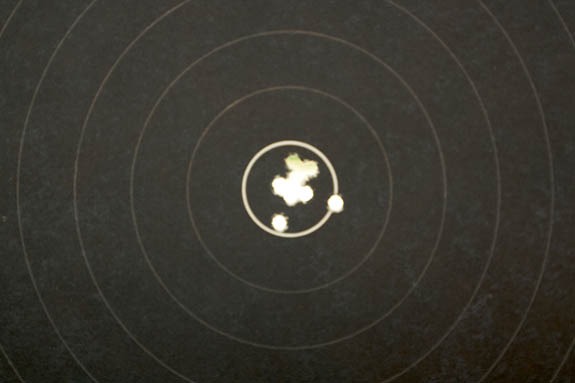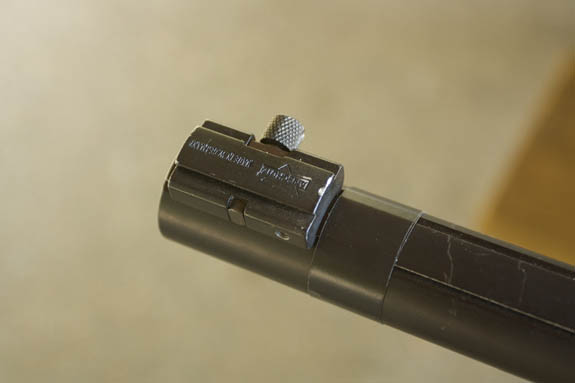Tune-Up
By Dan Holmes
This spring I decided to try a bloop tube on the end of my barrel to see if it helped me see the front sight more clearly. So 2 months ago, I started shooting irons with the new tube and was very pleased with the improvement in sight picture (and I think think it helped my sight alignment, as well). In fact, I was so pleased with my results that I just kept shooting irons, leaving my trusty scope in my bag in favor of getting the extra practice with the metallic sights prior to Camp Perry.
Then, at last Thursday’s HPM, I decided I would throw the scope back on in preparation for the MA State Championship. I left the new bloop tube on my barrel but took off the front sight and riser block (I should note that my particular tube has three holes in the end of it to accommodate a sight block if one is desired). After the match, I wasn’t real pleased with my results. My groups were widely dispersed and shots were not going where I was calling them. I chalked it up to the fact that I wasn’t shooting my “good” lot of ammo–I have taken to hoarding my good lot of Eley because I only have 1500 rounds left and can’t afford to do some proper lot testing and the moment.
So Saturday morning I headed off to the State Championship with a lot of Eley black that had performed adequately prior to using the new tube. I shot the prone stage of the match and had the same result,widely dispersed groups and shots not going where I called them. Frustrating.
About half way through the match, I began to wonder more about how removing the front sight might be effecting the harmonics of my rifle and began to hash it out with my teammates Len Remaly and Erik Hoskins. Not only is removing the front sight taking a chunk of weight off the end of the tube, but the front sight is also covering the tap holes that are in the end of the tube. I know of several shooters that flip the tube upside down so the sight hangs off the bottom when they shoot scope. I also know of one shooter (Hap Rocketto) that just leaves his front sight on and the scope just “sees” through it. Neither of these techniques seemed particularly appealing but since we were now in the standing stage of the match, I didn’t think that tinkering with the tube would give me much feedback so I decided to save the tinkering for another day.
So Monday I took advantage of a few rare hours of free time and went over to the range. My test would be simple. Use my good lot of Eley as I know it shoots good and shoot a group with no riser block/front sight and shoot a group with the just the riser block and a piece of electrical tape covering the one tap hole that the block doesn’t cover. I warmed the barrel, sighted in and shot a 10 shot group with the “naked” tube and then repeated the process with the block/electrical tape configuration. The conditions were identical for both groups, shot at 100 yards prone, no sight adjustments were made. The results are below.
That’s a pretty big difference in group size. Now I realize my test wasn’t particularly scientific or thorough but I do think it strongly suggests that removing the front sight and riser block does in fact reduce accuracy on my rifle. I repeated the test again with similar results. What’s it all mean? Well, it means I can’t continue to ignore all of the discussion about “tuning” that I hear on the range and on the web. That said, I’m not sure I’ll be running out and buying a proper tuner any time soon…after all I’m getting pretty good results so far with a 30-year-old riser block and a little electrical tape!
[ad#Adsense]





WOW, nice group Dan.The next test needs to be with no riser block and just tape over the holes. That will really clear up any thoughts of it being “The Tune”.
Awesome group!!!!!
Dan,
My belief is that the extra mass of the block and sight causes your barrel to bend slightly downward toward six o’clock, thereby “indexing” it as Mike Ross might say.
I leave my tube and sight on so that the rifle is essentially in the same configuration at all times because, not only am I aimimhg at the target, but I am also aming for consistency. The front sight is not visable through the scope.
Tunerism, as practiced by the bench rest community, does not interest me as it wastes too much ammunition and it adds weight and confusion.
Erik is correct in that you do need to extend your testing, but that is a great group so you are on the right track.
Hap
Nice test. However, I’m wondering if you can slide the front sight back and forth on the tube to find the sweet spot and alternatively the sour spots. If harmonic tuning is going on with the added weight of the sight the group size should be changing with different front sight placements. This would be difficult to test because I’m clueless on what the period of the wave is, 1/8 inch or .00001″. Or maybe it is as simple as adding weight on the barrel to slow the harmonics down so that the bullet can get out the barrel with less harmonic interference.
I’m doubtful of the small holes being covered with tape having much of an effect on accuracy. The gas expanding from the muzzle is going much faster than the bullet so should take the path of least resistance in its expansion ( the end of the tube). The small holes will have some gas going through it but I’m doubtful the turbulence from the gas going out the holes will create an adverse effect of the bullets path.
Dan,
Great group with your “tuned tube” at 100 yds. Looks like about 1/2″ group, which is a bit beyond the accuracy of most lots of even the best ammo. Knowing the configuration you used to shoot the good group is probably good enough to keep shooting that lot of ammo. The next question, is what a different lot of ammo will shoot with the “good config.” vs. no riser, no tape, etc. When we test lots of ammo, are we just trying to find a lot that shoots good with the “standard rifle configuration”. This is just a way to tune your ammo to fit your rifle, rather that tuning your rifle to fit the ammo.
Keep shooting those 1/2″ groups.
Len
Dan, I did try taking off the long tube during the first day of any sights. I did on the first target of the 100 yard match. I shot 10 shots, non of them touched each other, and non of them were in the 10 ring. I stopped, screwed it back on, and finished up winning the day. I didnt think it would matter much, I was wrong! Maybe a bit of tuning would help me get some more X’s, now what do I do, I leave for Benning on Tuesday??????????